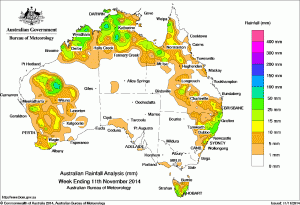
Rainfall recorded across Australia for the seven days to Tuesday, 11 November 2014. Click on map to view in larger format.
Rainfall over the past week was recorded in Western Australia, the Northern Territory, Queensland, northeast New South Wales and Tasmania.
At the start of the week, a trough of low pressure across the tropical north generated isolated thunderstorms with moderate rainfall totals recorded through the Kimberley district in Western Australia, across the northern half of the Northern Territory, the Gulf Country and Cape York Peninsula in Queensland.
The low pressure trough extended through New South Wales bringing showers and thunderstorms to the central and northern ranges, with heavier falls recorded along the northern coast. The trough also resulted in light to moderate rainfall totals through Queensland’s interior.
During the middle of the week, a cold front tracked across Tasmania bringing light rainfall to the west coast. Thunderstorms and showers continued to form along areas of low pressure over northern Australia, with moderate falls being recorded in the Kimberley district in Western Australia and across isolated parts of Arnhem Land and Cape York Peninsula. A weak cold front crossed southwest Western Australia and produced light rain for the coastal fringe.
At the end of the week, a low pressure system located over the Kimberley district and a surface trough that extended south into the Great Australian Bight generated widespread thunderstorms and showers. Moderate rainfall totals were recorded in western, northern and central Western Australia.
Rainfall totals in excess of 50 mm were reported in isolated areas of the Darwin-Daly district in Northern Territory and in the northern Kimberley and Gascoyne districts in Western Australia. The highest weekly total was 111 mm at Fort Hill Wharf in the Northern Territory.
Rainfall totals between 25 mm and 50 mm were recorded in the Kimberley and Gascoyne districts in Western Australia, in northwest parts of the Northern Territory, isolated parts of northwest Queensland, in northeastern New South Wales, and in parts of western and eastern Tasmania.
Rainfall totals between 15 mm and 25 mm were recorded in areas surrounding higher falls in central and northern Western Australia, isolated parts of southwest Western Australia, the Top End of the Northern Territory, Gulf Country and western Cape York Peninsula, small parts of inland Queensland, northeastern New South Wales, and Tasmania’s east and west.
South Australia, Victoria, southwest Queensland, central and inland New South Wales, the interior of the Northern Territory and large areas of eastern Western Australia recorded little or no rainfall for the week.
Warm tropical Pacific waters, but ENSO remains neutral
El Niño–Southern Oscillation (ENSO) indicators and Australian rainfall patterns continue to show some El Niño-like signatures, however, ENSO remains in the neutral range. Sea surface temperatures (SSTs) in the tropical Pacific Ocean have warmed over the past two months, with the latest NINO3.4 SST anomaly at +0.8 °C. The latest Southern Oscillation Index value to 9 November 2014 is −13.2.
Highest rainfall totals in each state:
| State | Highest | 2nd Highest | 3rd Highest |
|---|---|---|---|
| WA | Mount Elizabeth (49 mm) (North Kimberley) |
Weelarrana (48 mm) (East Gascoyne/Murchison) |
Siddins Creek (42 mm) (East Kimberley) |
| NT | Fort Hill Wharf (111 mm) (Darwin-Daly) |
Jabiru Airport (90 mm) (Darwin-Daly) |
The Chase (89 mm) (Darwin-Daly) |
| SA | Clarendon (4 mm) (East Central) |
Ceduna (3 mm) (Western Agricultural) |
Streaky Bay (3 mm) (Western Agricultural) |
| Qld | Scherger (55 mm) (North Peninsula) |
Donors Hill Station (52 mm) (Lower Carpentaria) |
Forsayth (28 mm) (Upper Carpentaria) |
| NSW/ACT | Mount George (63 mm) (Manning) |
Mangrove Mountain (57 mm) (Hunter) |
Busbys Flat (49 mm) (Upper North Coast) |
| Vic | Falls Creek (29 mm) (Upper Northeast) |
Main Ridge (10 mm) (East Central) |
Daylesford (10 mm) (North Central) |
| Tas | Friendly Beaches (52 mm) (East Coast) |
Tasman Island (46 mm) (Southeast) |
Mount Read (39 mm) (West Coast) |
Source: BOM
